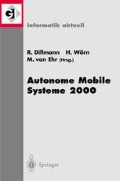Zusammenfassung
Mobile Robotersystetne werden heute meist über graphische Oberflächen in Standard-PCs, PDAs oder Teachpanel kommandiert. Auditive und gestenbasierte Kommandierungen sind seit wenigen Jahren hochaktuelle Forschungsthemen mit dem Ziel, die Schnittstellen zwischen Menschen und Maschinen direkter und intuitiver zu gestalten. Entsprechend den Bewegungen, die Menschen beim Einweisen von Fahrzeugen machen, wird am Institut für Prozessrechentechnik, Automation und Robotik der Einsatz dynamischer Gesten zur Anweisung einer mobilen Plattform untersucht. „Dynamisch“ soll hierbei bedeuten, dass bei der Interpretation der Benutzerhandlungen hier ausschliesslich die Verfahrbahn einer der beiden Hände bedeutungstragend ist. Die Gelenkstellungen von Fingern und Handgelenken fließen nicht in die Gestenklassifikation ein.
Access this chapter
Tax calculation will be finalised at checkout
Purchases are for personal use only
Preview
Unable to display preview. Download preview PDF.
Literatur
A. Arsenio and J. Santos-Victor. Robust visual tracking by an active observer. In Proceedings of the IEEE International Conference on Intelligent Robots and Systems (IROS), volume 3, pages 1342–1347, 1997.
A. Blake and M. Isard. Active Contours. Springer, 1998.
G. Forney. The viterbi algorithm. Proceedings of the IEEE, 61 (3): 268–278, März 1973.
D. Gavrila and L. Davis. Towards 3d model-based tracking and recognition of human movement: a multi-view approach. In International Workshop on Face and Gesture Recognition, Zürich, 1995.
T. Heap and F. Samaria. Real-time hand tracking and gesture recognition using smart snakes. Technical report, Olivetti Research Limited, 20. Juni 1995.
H. Kestler, M. Borst, and H. Neumann. Einfache Handgestikerkennung mit einem zweistufigen Nearest-Neighbour Klassifikator. Technical report, Universität Ulm, SFB 527, 96 /6, 1996.
J. Kim, W. Jang, and Z. Bien. A dynamic gesture recognition system for the korean sign language (KSL). IEEE Transactions on Systems, Man and Cybernetics-Part B: Cybernetics, 26 (2): 354–359, April 1996
M. Kohler. Übersicht Handgestenerkennung. http://ls7-www.cs.uni-dortmund.de/research/gesture/2000.
C. Lee and Y. Xu. Online, interactive learning of gestures for human/robot interfaces, Mminneapolis, Minnesota. In Proceedings of the IEEE International Conference on Robotics and Automation, April 1996.
H. Lee and J. Kim. An HMM-based threshold model approach for gesture recognition. IEEE Transactions on Pattern Analysis and Machine Intelligence, 21 (10): 961–973, Oktober 1999.
D. Newtson and et al. The objective basis of behaviour units. Journal of Personality and Social Psychology, 35, 1977.
P. Nordlund and T. Uhlin. Closing the loop: Detection and pursuit of a moving object with sensors onboard a moving robot. Image Vision and Computing, 14 (4): 265–275, 1996.
A. Pentland. Looking at people: Sensing for ubiquitous and wearable computing. IEEE Transactions on Pattern Analysis and Machine Intelligence, 22 (1): 107–119, Januar 2000.
R. Plamnondon and S. Srihari. On-line and off-line handwriting recognition: A comprehensive survey. IEEE Transactions on Pattern Analysis and Machine Intelligence, 22 (1): 63–84, Januar 2000.
L. Rabiner. A tutorial on Hidden Markov Models and selected applications in speech recognition. Proceedings of the IEEE, 77 (2): 257–285, Februar 1989.
J. Rehg and T. Kanade. Visual tracking of high DOF articulated structures: an application to human hand tracking. In ECCV, pages 35–46, 1994.
M. S. Ryan and G. R. Nudd. The viterbi algorithm. Warwick Research Report RR 238, Department of Computer Science, University of Warwick, Coventry, Februar 1993.
N. Shimoda and Y. Shirai. 3d hand pose estimation and shape model refinement from a monocular image sequence. In Proceedings of the VSMM, Gifu, pages 423–428, 1996.
H. Sidenbladh, D. Kragic, and H. Christensen. A person following behaviour for a mobile robot. In Proceedings of the IEEE International Conference on Robotics and Automation, Detroit, MI, USA, pages 670–675, April 1999.
T. Starner. Real-time american sign language recognition from video using hidden Markov models. In Proceedings of the IEEE International Symposium on Computer Vision, pages 265–270, 1995.
J. Triesch and Chr. von der Malsburg. Robotic gesture recognition. In Proceedings of the Bielefeld Gesture Workshop. Springer, 17–19. September 1997.
M. Yamamoto and K. Koshikawa. Human motion analysis based on a robot arm model. In CVPR, pages 664–665, 1991.
J. Yang, W. Lu, and A. Waibel. Skin-color modeling and adaptation. In Proceedings of ACCV, Hong Kong, volume 2, pages 687–694, 1998.
Author information
Authors and Affiliations
Editor information
Editors and Affiliations
Rights and permissions
Copyright information
© 2000 Springer-Verlag Berlin Heidelberg
About this paper
Cite this paper
Ehrenmann, M., Lütticke, T., Dillmann, R. (2000). Erkennung dynamischer Gesten zur Kommandierung mobiler Roboter. In: Dillmann, R., Wörn, H., von Ehr, M. (eds) Autonome Mobile Systeme 2000. Informatik aktuell. Springer, Berlin, Heidelberg. https://doi.org/10.1007/978-3-642-59576-9_3
Download citation
DOI: https://doi.org/10.1007/978-3-642-59576-9_3
Publisher Name: Springer, Berlin, Heidelberg
Print ISBN: 978-3-540-41214-4
Online ISBN: 978-3-642-59576-9
eBook Packages: Springer Book Archive

